INTRODUCTION, FLIGHTS, ACCOMMODATION etc.
Portugal is not like a conventional birding holiday for Amanda & I; we have now visited the Algarve 10 times since 1992. We always book a villa independently with Barbara Read Villas. We first met Barbara in 1994 and we now regard her as a good friend. Unless travelling off-peak season, the villas do not come cheap for two as most are 2 or 3+ beds, but they are all individual, private and give us the living space we like which enables us to quickly relax right at the start of our holiday.
I don’t think you will be disappointed. If you do decide to book with Barbara please give us a mention. Barbara also arranges very convenient and reasonably priced car hire with a local operator in Lagos. Cars can be picked up and dropped off at the airport without the usual hassle associated with the larger operators such as journeys by coach to and from the airport to the local depots. Flights to the Algarve are now relatively easy to come by from a variety of airports around the UK. We have always travelled from Manchester and usually with Monarch in recent years.
If you wish to keep costs down and are not too bothered about the quality and size of the accommodation, there are any number of package holidays available from all destinations within the UK and at prices to suit any pocket.
Although it is now very unlikely any new lifers will be added during a trip to Portugal, we continue to add to our Portuguese List and from holiday lists of c100 in the early days, we now regularly clock up 150+ species in a two week stay, almost irrespective of the time of year. We always enjoy Portugal as a birding destination for a relaxing holiday combined with special species not regularly seen in the UK.
RESEARCH and TRIP ESSENTIALS
Tourist maps of the Algarve and of Portugal/Spain (for trips further inland) are readily available at the new motorway service areas or local tourist shops.
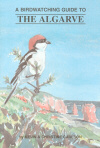 The main site books used were A Birdwatching Guide to the Algarve by Kevin and Christine Carlson (ISBN 1 900159 00 7) and Finding Birds in Southern Portugal by Dave Gosney (ISBN 1 898110 18 2). Similar sites are also covered in the more extensive Hamlyn Birdwatching Guide – Where to Watch Birds in Spain and Portugal (Where to Watch Birds) by Laurence Rose (ISBN 0 600 58404 6).
The main site books used were A Birdwatching Guide to the Algarve by Kevin and Christine Carlson (ISBN 1 900159 00 7) and Finding Birds in Southern Portugal by Dave Gosney (ISBN 1 898110 18 2). Similar sites are also covered in the more extensive Hamlyn Birdwatching Guide – Where to Watch Birds in Spain and Portugal (Where to Watch Birds) by Laurence Rose (ISBN 0 600 58404 6).
FOOD
Numerous supermarkets around the Lagos area make self-catering easy.
Restaurants we can recommend are:-
- Reis, Rua Antonio B. Viana, Lagos. Tel 282 762900
- O Galeao, Rua da Laranjeira, Lagos. Tel 282 763 909
- A Lagosteira, Rua 1° de Maio, Lagos. Tel 282 760427
- Nortada, Praia do Martinhal, Sagres. Tel 282 624147
- Fortelaza da Luz, Luz. Tel 282 789926
ITINERARY
- 29/12/2003 Arrive Faro – Lagos – Alvor Estuary
- 30/12/2003 Cape St Vincent – Martinhal
- 31/12/2003 Carrapateira – Pera Marsh
- 1/1/2004 Burgau Marsh – Martinhal – Pera Marsh – Odelouca Valley
- 2/2/2004 Castro Marim
- 3/2/2004 Burgau Marsh
- 4/1/2004 Burgau Marsh – Martinhal – Cape St Vincent – Lagos
- 5/1/2004 Quinta do Lago – Alvor Estuary
- 6/1/2004 Cape St Vincent – Martinhal – Barranco Joao Vaz
- 7/1/2004 Castro Verde
- 8/1/2004 Burgau Marsh – Cape St Vincent – Alvor Estuary
- 9/1/2004 Pera Marsh
- 10/1/2004 Cape St Vincent – Lagos – Alvor Estuary
- 11/1/2004 Pera Marsh
- 12/1/2004 Return flight Faro – Manchester
SITES
In the main, the maps and directions in the Site Guides are good. There are however one or two notes below, which point to additional areas well worth further examination.
Some journey times have been dramatically improved following the opening of additional motorway stretches west to Lagos and north near Albufeira towards the Alantejo.
As a guide to birds which are likely to be seen at the various sites, links have been created to lists I have seen over the years and can be accessed by clicking on the site name.
Alantejo/Castro Verde/Mertola – Gosney Pg 26, Rose Pg 181
(Castro Verde – Bird List & Mertola – Bird List)
Do not visit this area on Sundays as the local hunters are out in force and birds are almost non existent. Visits in the last three years have not been as productive as earlier years, possibly as a result of increased disruption from hunters. Having arrived at Mertola, the onward, return journey towards the coast at Castro Marim or inland towards Loulé is quite time consuming. Although there are a few nice habitats on the way, which are well worth short stops, we have recently retraced our footsteps to the motorway near Castro Verde if time was critical.
Alvor Estuary – Carlson Pg 12, Gosney Pg 10, Rose Pg 184 (Bird List)
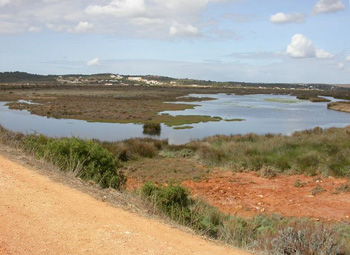
A walk around the salt pans on the raised embankments is recommended for both waders and gulls/terns. Collared Pratincoles can be a star turn in Sept/Oct. The west bank of the estuary does not get a mention in the guide books but is well worth a visit, especially at high tide. Access is either from east of Lagos via Meia Praia and Palmares golf course following the coastal track around the fish tanks, eventually rejoining the N125 east of Odiáxere, or in reverse if travelling from the Portimão side.
Barranco Joao Vaz
Leaving the N125 at Raposeira this is an interesting drive down a river valley with diverse habitats to a deserted sandy bay. In January 2004, our first visit, the area was rich with Blackcaps, Chiffchaffs, Redwings and Ring Ouzels.
Burgau Marsh – Carlson Pg 11 (Bird List)
Bird numbers fluctuate dramatically dependant on season, but always worth a visit on the way west to Sagres and Cape St Vincent.
Cape St Vincent/Sagres – Carlson Pg 10, Gosney Pg 12, Rose Pg 183
(Cape St Vincent – Bird List & Sagres – Bird List)
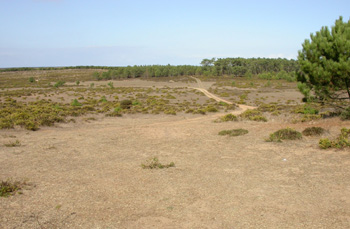 The tracks around the Cape should be visited at every opportunity, especially in Sept/Oct. Most are driveable and although our last few visits have not yielded Little Bustards, the variety of species is almost always guaranteed. The main tracks in question are not shown in the guide books, but start immediately after the Taverna de Beliche. Turning right by the Taverna, two tracks head north, straight inland, and run either side of a small strand of trees for c1000m. At the end of the trees the tracks join and head right (east) along another stand of trees towards a trig point on a small hill, which is visible almost as soon as you first join the tracks. The trig point is an excellent vantage point to watch raptors in late September, early October, especially after a strong easterly wind or preferably storm. The birds rest in the surrounding fields and woodlands overnight and as the day heats up (usually 10.00 hrs onwards) they can be seen circling and gathering height overhead, prior to continuing their southward migration.
The tracks around the Cape should be visited at every opportunity, especially in Sept/Oct. Most are driveable and although our last few visits have not yielded Little Bustards, the variety of species is almost always guaranteed. The main tracks in question are not shown in the guide books, but start immediately after the Taverna de Beliche. Turning right by the Taverna, two tracks head north, straight inland, and run either side of a small strand of trees for c1000m. At the end of the trees the tracks join and head right (east) along another stand of trees towards a trig point on a small hill, which is visible almost as soon as you first join the tracks. The trig point is an excellent vantage point to watch raptors in late September, early October, especially after a strong easterly wind or preferably storm. The birds rest in the surrounding fields and woodlands overnight and as the day heats up (usually 10.00 hrs onwards) they can be seen circling and gathering height overhead, prior to continuing their southward migration.  The widest track, a little further west from the Taverna, heads inland towards a farm, visible in the distance from the road, and onwards to Vila Do Bispo. This track is well worth taking (we had a pair of Black-shouldered Kites regularly in Jan 2004 near Vila Do Bispo) as are the small offshoots heading towards the coast by the previously mentioned farm. Birds at the Cape itself can be a little disappointing at times.
The widest track, a little further west from the Taverna, heads inland towards a farm, visible in the distance from the road, and onwards to Vila Do Bispo. This track is well worth taking (we had a pair of Black-shouldered Kites regularly in Jan 2004 near Vila Do Bispo) as are the small offshoots heading towards the coast by the previously mentioned farm. Birds at the Cape itself can be a little disappointing at times.
There is also a small site at Sagres, not mentioned in any of the guides, which is excellent at migration time as it is the only stand of trees for some distance. As well as numerous warblers and flycatchers I have seen up to 4 Wryneck here at one time in autumn. Taking the N268 into Sagres, turn right at the island (where there is a left turn to Sagres town and straight ahead leads to the Fort at Ponta de Sagres) towards Cape St Vincent. Almost immediately on the right hand side of the road, after a Pottery and before the building compound with the radio masts, there is a large pull in space by some small conifers. This wooded area, plus the disused gardens/allotments nearby are always worth a call when migrants are around.
As regards Sagres itself, I have always found the best sea-watching spot is the headland by the Henry the Navigator luxury hotel rather than from the Fort. Turning left at the island at the end of the N268 mentioned above, follow the minor road through the town towards the harbour. The hotel is set back on the right almost at the end of the town and before the road starts going downhill to the harbour. The track at the end of the hotel road leads onto the headland, which is also favoured by Black Redstarts, wagtails, pipits and warblers and on one occasion, an Ortolan Bunting.
Carrapateira – Carlson Pg 11 (Bird List)
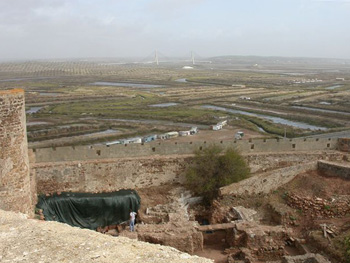 North of Carrapateira in suitable habitat by the roadside we have previously seen Cirl Bunting on most trips.
North of Carrapateira in suitable habitat by the roadside we have previously seen Cirl Bunting on most trips.
Castro Marim – Carlson Pg 27/31, Gosney Pg 30, Rose Pg 188 (Bird List)
The salt pans to the right/east of N122 around Castro Marim are well worth exploring at any access point, for waders and also Little Bustard.
Martinhal (Bird List)
Leaving Sagres on the N268 towards Vila Do Bispo take the fist right turn leading to the north end of Sagres harbour/bay. The small tidal pool, which usually contains brackish water as only the highest tides breach the entrance, usually contains a variety of waders and gulls. But, more importantly, the beach bar Nortada (not the first, surfers bar) has excellent food, is open all year and is ideal for lunch when visiting the area.
Odelouca Valley – Carlson Pg 35 (Bird List)
Can be a little disappointing at times and not one of my favourite sites.
Pera Marsh – Carlson Pg 14 (Bird List)
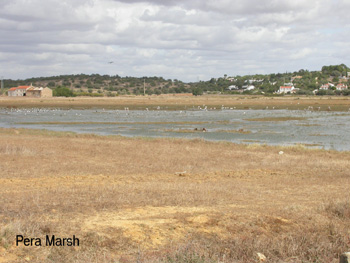 One of the best little habitats on the Algarve and regrettably under threat from local developers. Four visits in January 2004 tell their own story! Can be a little difficult to find at first, but from N125 east of Alcantarilha at traffic light junction, take road to Armação de Pêra and almost immediately take a minor road left across a narrow bridge. Over the bridge veer right (straight on goes into Pêra) and follow this road around the outskirts of the town, going up a slight incline to an “island” at the top of the rise (circular building in fields to the right) and turn right (main road carries on to Albufeira) taking the small road down to the beach. This road and Pera Marsh are to the west of the golf course – Salgardos. The minor road eventually deteriorates into a track to the main beach car park. Tracks to the left, off this main track go right to the waters edge.
One of the best little habitats on the Algarve and regrettably under threat from local developers. Four visits in January 2004 tell their own story! Can be a little difficult to find at first, but from N125 east of Alcantarilha at traffic light junction, take road to Armação de Pêra and almost immediately take a minor road left across a narrow bridge. Over the bridge veer right (straight on goes into Pêra) and follow this road around the outskirts of the town, going up a slight incline to an “island” at the top of the rise (circular building in fields to the right) and turn right (main road carries on to Albufeira) taking the small road down to the beach. This road and Pera Marsh are to the west of the golf course – Salgardos. The minor road eventually deteriorates into a track to the main beach car park. Tracks to the left, off this main track go right to the waters edge.
Quinta do Lago/Ria Formosa – Carlson Pg 15, Gosney Pg2, Rose Pg 186 (Bird List)
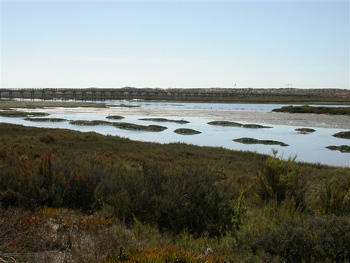 I think the best way to view this extensive site is to head for the beach car park at Quinta do Lago at the end of the seven islands on the Ave André Jordon (Carlson Pg 16 & Gosney Pg 3). From the car park head towards the beach and turn left immediately prior to the wooden footbridge and follow the path around the edge of the golf course. The maps in Gosney Pg 5 & 7 clearly show the route around to Ludo Farm. The track leading from the golf course to the farm has a sign for the emergency exit road from the airport – don’t worry. The salt pans between the golf course and the farm are excellent for waders etc.
I think the best way to view this extensive site is to head for the beach car park at Quinta do Lago at the end of the seven islands on the Ave André Jordon (Carlson Pg 16 & Gosney Pg 3). From the car park head towards the beach and turn left immediately prior to the wooden footbridge and follow the path around the edge of the golf course. The maps in Gosney Pg 5 & 7 clearly show the route around to Ludo Farm. The track leading from the golf course to the farm has a sign for the emergency exit road from the airport – don’t worry. The salt pans between the golf course and the farm are excellent for waders etc.
Monchique – Carlson Pg 33, Rose P g 184 (Bird List)
We don’t always visit this area as birding can be a little disappointing other than a number of specialist woodland birds and the occasional treat (Rock Bunting and raptors) from the peak Fóia.
Although I have not yet been to Olhao & Fuseta (Carlson Pg 24) and Tavira (Carlson Pg 26) a colleague advises they are well worth a visit for waders, especially in autumn.
BIRDING IN DECEMBER 2003/JANUARY 2004
Personal highlights were:-
Alvor Osprey 29/12 & 5/1 Whimbrel 29/12 & 8, 10/1
Castro Marim c21 Little Bustard 2/1 Spotted Redshank 2/1 c50 Little Stint 2/1 c10 Curlew Sandpiper 2/1 Red-rumped Swallow 2/1
Cape St Vincent Pair of Black-shouldered Kite 30/12 & 4, 6, 10/1 Blue Rock Thrush 30/12 c100 Chough feeding in fields 4/1 Pair of Ring Ouzel settled in for the winter on Juniper bushes
Castro Verde/Mertola 3 Black-shouldered Kite 7/1 c30 Little Bustard 7/1 2 Calandra Lark 7/1
Pera c100 Little Grebe 31/12 up to 12 Spoonbill 31/12 to 9/1 20 Greater Flamingo 31/12 Drake Ferruginous Duck 9/01 up to 20 Purple Swamphen 11/1 Slender-billed Gull 31/12 4 Woodlark 11/1 Dartford Warbler 9/1 3 Bluethroat (white-spotted) 9/1
Quinta do Lago Spotted Redshank 5/1 c100 Little Stint 5/1 Gull-billed Tern 5/1
Species seen at each site are detailed in the 2003/4 Trip List below. For comparison you can also access my Portugal Life List covering 1992 to date.
Portugal Bird Species Checklist *Excel
Trip List 2003/4
| Name | Species | Where Seen |
| Little Grebe | Tachybaptus ruficollis | A, AL, CM, P, Q |
| Great Crested Grebe | Podiceps cristatus | Q |
| Gannet | Morus bassanus | B, C, M |
| Cormorant | Phalacrocorax carbo | Common |
| Shag | Phalacrocorax aristotelis | M, Q |
| Little Egret | Egretta garzetta | Common |
| Grey Heron | Ardea cinerea | Common |
| Great Egret | Ardea alba | P |
| Cattle Egret | Bubulcus ibis | Common |
| White Stork | Ciconia ciconia | Common |
| Spoonbill | Platalea leucorodia | P, Q |
| Greater Flamingo | Phoenicopterus ruber | P |
| Wigeon | Anas penelope | Q |
| Gadwall | Anas strepera | CM, P, Q |
| Teal | Anas crecca | A, AL, P, Q |
| Mallard | Anas platyrhynchos | Common |
| Pintail | Anas acuta | P, Q |
| Shoveler | Anas clypeata | AL, CM, P, Q |
| Pochard | Aythya ferina | P, Q |
| Ferruginous Duck | Aythya nyroca | P |
| Tufted Duck | Aythya fuligula | P, Q |
| Black-shouldered Kite | Elanus caeruleus | AL, C, CA |
| Red Kite | Milvus milvus | AL |
| Marsh Harrier | Circus aeruginosus | CM, P |
| Hen Harrier | Circus cyaneus | AL, C |
| Buzzard | Buteo buteo | Common |
| Booted Eagle | Hieraaetus pennatus | B, Q |
| Osprey | Pandion haliaetus | A, M |
| Kestrel | Falco tinnunculus | Common |
| Peregrine Falcon | Falco peregrinus | B, C, P |
| Red-legged Partridge | Alectoris rufa | Common |
| Purple Swamphen | Porphyrio porphyrio | P, Q |
| Moorhen | Gallinula chloropus | P, Q |
| Coot | Fulica atra | CM, P, Q |
| Little Bustard | Tetrax tetrax | CM, AL |
| Oystercatcher | Haematopus ostralegus | A |
| Black-winged Stilt | Himantopus himantopus | Common |
| Avocet | Recurvirostra avosetta | P |
| Golden Plover | Pluvialis apricaria | A, AL, C, P |
| Grey Plover | Pluvialis squatarola | A, CM, P, Q |
| Ringed Plover | Charadrius hiaticula | A, CM, M, P, Q |
| Kentish Plover | Charadrius alexandrinus | A, CM, M |
| Lapwing | Vanellus vanellus | A, AL, C, CM, P, Q |
| Black-tailed Godwit | Limosa limosa | A, CM, P |
| Whimbrel | Numenius phaeopus | A, M, Q |
| Curlew | Numenius arquata | A, Q |
| Spotted Redshank | Tringa erythropus | CM, Q |
| Redshank | Tringa totanus | A, CM, Q |
| Greenshank | Tringa nebularia | A, CM, P, Q |
| Green Sandpiper | Tringa ochropus | B, A |
| Common Sandpiper | Actitis hypoleucos | A, B, CM, M, P, Q |
| Turnstone | Arenaria interpres | A, M, P |
| Knot | Calidris canutus | A, P, Q |
| Sanderling | Calidris alba | A, M, P, Q |
| Little Stint | Calidris minuta | A, CM, Q |
| Dunlin | Calidris alpina | A, CM, Q |
| Curlew Sandpiper | Calidris ferruginea | A, CM, Q |
| Ruff | Philomachus pugnax | P, Q |
| Yellow-legged Gull | Larus cachinnans michahellis | A, C, CM, M, P, Q |
| Lesser Black-backed Gull | Larus fuscus graellsi | A, CM, M, P, Q |
| Black-headed Gull | Larus ridibundus | A, C, CM, M, P, Q |
| Slender-billed Gull | Larus genei | P |
| Mediterranean Gull | Larus melanocephalus | P, A |
| Gull-billed Tern | Sterna nilotica | Q |
| Caspian Tern | Sterna caspia | A, CM, P |
| Sandwich Tern | Sterna sandvicensis | A, M, P, Q |
| Rock Dove | Columba livia | C |
| Collared Dove | Streptopelia decaocto | Common |
| Barn Owl | Tyto alba | QA |
| Little Owl | Athene noctua | A, AL, QA |
| Kingfisher | Alcedo atthis | A, O, Q |
| Hoopoe | Upupa epops | A, P, QA |
| Great Spotted Woodpecker | Dendrocopos major | CA |
| Green Woodpecker | Picus viridis | Q |
| Calandra Lark | Melanocorypha calandra | AL |
| Short-toed Lark | Calandrella brachydactyla | C |
| Crested Lark | Galerida cristata | A, AL, CA, CM, R, P |
| Thekla Lark | Galerida theklae | B, C |
| Wood Lark | Lullula arborea | C, P |
| Skylark | Alauda arvensis | AL, C, CA |
| Crag Martin | Hirundo rupestris | Common |
| Barn Swallow | Hirundo rustica | A, CM, M, P |
| Red-rumped Swallow | Hirundo daurica | CM |
| Meadow Pipit | Anthus pratensis | Common |
| Rock Pipit | Anthus petrosus | P |
| White Wagtail | Motacilla alba | Common |
| Grey Wagtail | Motacilla cinerea | AL, B |
| Robin | Erithacus rubecula | A, C, QA |
| White-spotted Bluethroat | Luscinia svecica cyanecula | P |
| Black Redstart | Phoenicurus ochruros | A, AL , B, C, M, QA, R |
| Whinchat | Saxicola rubetra | A, P, Q |
| Stonechat | Saxicola torquata | Common |
| Blue Rock Thrush | Monticola solitarius | C, M |
| Ring Ouzel | Turdus torquatus | C, R |
| Blackbird | Turdus merula | Common |
| Fieldfare | Turdus pilaris | C |
| Redwing | Turdus iliacus | B, C, R |
| Song Thrush | Turdus philomelos | A, B, QA, R |
| Mistle Thrush | Turdus viscivorus | C, V |
| Cetti’s Warbler | Cettia cetti | B |
| Zitting Cisticola | Cisticola juncidis | A, C, CM, P, Q, QA |
| Sedge Warbler | Acrocephalus schoenobaenus | A |
| Reed Warbler | Acrocephalus scirpaceus | P |
| Melodious Warbler | Hippolais polyglotta | A |
| Blackcap | Sylvia atricapilla | B, QA, R |
| Sardinian Warbler | Sylvia melanocephala | A, B, C, Q, QA, R |
| Dartford Warbler | Sylvia undata | B, C, CM, P, R |
| Willow Warbler | Phylloscopus trochilus | A, B |
| Chiffchaff | Phylloscopus collybita | Common |
| Iberian Chiffchaff | Phylloscopus collybita ibericus | AL |
| Great Tit | Parus major | A, AL, CA, QA |
| Blue Tit | Parus caeruleus | QA |
| Southern Grey Shrike | Lanius excubitor meridionalis | Common |
| Jay | Garrulus glandarius | CA, O |
| Azure-winged Magpie | Cyanopica cyana | Common |
| Magpie | Pica pica | AL |
| Chough | Pyrrhocorax pyrrhocorax | C |
| Jackdaw | Corvus monedula | A, AL, B, C |
| Carrion Crow | Corvus corone | AL, C |
| Raven | Corvus corax | AL, C |
| Spotless Starling | Sturnus unicolor | Common |
| House Sparrow | Passer domesticus | Common |
| Spanish Sparrow | Passer hispaniolensis | A |
| Waxbill | Estrilda astrild | P, Q |
| Chaffinch | Fringilla coelebs | CA, O, QA |
| Serin | Serinus serinus | A, O, Q, QA, R |
| Greenfinch | Carduelis chloris | A, C, CM, P, QA, R |
| Goldfinch | Carduelis carduelis | Common |
| Linnet | Carduelis cannabina | A, AL, B, C. P, R |
| Bullfinch | Pyrrhula pyrrhula | CA |
| Corn Bunting | Miliaria calandra | AL, B, C, CM, R |
| KEY | |
| Alantejo | AL |
| Alvor Estuary | A |
| Burgau Marsh | B |
| Cape St Vincent | C |
| Carrapeteira | CA |
| Castro Marim | CM |
| Lagos | L |
| Martinhal | M |
| Odelouca Valley | O |
| Pera Marsh | P |
| Quinta de Lago | Q |
| Raposeira | R |
| Seen in all appropriate Habitats | Common |
| Villa near Luz | QA |
Portugal Life List
| Name | Species |
| Little Grebe | Tachybaptus ruficollis |
| Great Crested Grebe | Podiceps cristatus |
| Black-necked Grebe | Podiceps nigricollis |
| Cory’s Shearwater | Calonectris diomedea |
| Manx Shearwater | Puffinus puffinus |
| Mediterranean Shearwater | Puffinus yelkouan |
| Gannet | Morus bassanus |
| Cormorant | Phalacrocorax carbo |
| Shag | Phalacrocorax aristotelis |
| Little Egret | Egretta garzetta |
| Grey Heron | Ardea cinerea |
| Purple Heron | Ardea purpurea |
| Great Egret | Ardea alba |
| Cattle Egret | Bubulcus ibis |
| Squacco Heron | Ardeola ralloides |
| Black Stork | Ciconia nigra |
| White Stork | Ciconia ciconia |
| Glossy Ibis | Plegadis falcinellus |
| Spoonbill | Platalea leucorodia |
| Greater Flamingo | Phoenicopterus ruber |
| Wigeon | Anas penelope |
| Gadwall | Anas strepera |
| Teal | Anas crecca |
| Mallard | Anas platyrhynchos |
| Pintail | Anas acuta |
| Shoveler | Anas clypeata |
| Red-crested Pochard | Netta rufina |
| Common Pochard | Aythya ferina |
| Ferruginous Duck | Aythya nyroca |
| Tufted Duck | Aythya fuligula |
| Honey Buzzard | Pernis apivorus |
| Black-shouldered Kite | Elanus caeruleus |
| Red Kite | Milvus milvus |
| Black Kite | Milvus migrans |
| Egyptian Vulture | Neophron percnopterus |
| Griffon Vulture | Gyps fulvus |
| Short-toed Eagle | Circaetus gallicus |
| Marsh Harrier | Circus aeruginosus |
| Hen Harrier | Circus cyaneus |
| Montagu’s Harrier | Circus pygargus |
| Sparrowhawk | Accipiter nisus |
| Goshawk | Accipiter gentilis |
| Common Buzzard | Buteo buteo |
| Spanish Imperial Eagle | Aquila adalberti |
| Golden Eagle | Aquila chrysaetos |
| Bonelli’s Eagle | Hieraaetus fasciatus |
| Booted Eagle | Hieraaetus pennatus |
| Osprey | Pandion haliaetus |
| Lesser Kestrel | Falco naumanni |
| Common Kestrel | Falco tinnunculus |
| Red-footed Falcon | Falco vespertinus |
| Eleonora’s Falcon | Falco eleonorae |
| Merlin | Falco columbarius |
| Hobby | Falco subbuteo |
| Peregrine Falcon | Falco peregrinus |
| Red-legged Partridge | Alectoris rufa |
| Quail | Coturnix coturnix |
| Purple Swamphen | Porphyrio porphyrio |
| Moorhen | Gallinula chloropus |
| Coot | Fulica atra |
| Little Bustard | Tetrax tetrax |
| Great Bustard | Otis tarda |
| Oystercatcher | Haematopus ostralegus |
| Black-winged Stilt | Himantopus himantopus |
| Avocet | Recurvirostra avosetta |
| Stone Curlew | Burhinus oedicnemus |
| Collared Pratincole | Glareola pratincola |
| Golden Plover | Pluvialis apricaria |
| Grey Plover | Pluvialis squatarola |
| Ringed Plover | Charadrius hiaticula |
| Little Ringed Plover | Charadrius dubius |
| Kentish Plover | Charadrius alexandrinus |
| Lapwing | Vanellus vanellus |
| Snipe | Gallinago gallinago |
| Black-tailed Godwit | Limosa limosa |
| Bar-tailed Godwit | Limosa lapponica |
| Whimbrel | Numenius phaeopus |
| Curlew | Numenius arquata |
| Spotted Redshank | Tringa erythropus |
| Redshank | Tringa totanus |
| Greenshank | Tringa nebularia |
| Green Sandpiper | Tringa ochropus |
| Wood Sandpiper | Tringa glareola |
| Common Sandpiper | Actitis hypoleucos |
| Turnstone | Arenaria interpres |
| Knot | Calidris canutus |
| Sanderling | Calidris alba |
| Little Stint | Calidris minuta |
| Temminck’s Stint | Calidris temminckii |
| Dunlin | Calidris alpina |
| Curlew Sandpiper | Calidris ferruginea |
| Ruff | Philomachus pugnax |
| Great Black-backed Gull | Larus marinus |
| Herring Gull | Larus argentatus |
| Yellow-legged Gull | Larus cachinnans michahellis |
| Lesser Black-backed Gull | Larus fuscus graellsi |
| Black-headed Gull | Larus ridibundus |
| Slender-billed Gull | Larus genei |
| Mediterranean Gull | Larus melanocephalus |
| Little Gull | Larus minutus |
| Kittiwake | Rissa tridactyla |
| Gull-billed Tern | Sterna nilotica |
| Caspian Tern | Sterna caspia |
| Sandwich Tern | Sterna sandvicensis |
| Common Tern | Sterna hirundo |
| Little Tern | Sterna albifrons |
| Whiskered Tern | Chlidonias hybrida |
| Black Tern | Chlidonias niger |
| Razorbill | Alca torda |
| Rock Dove | Columba livia |
| Stock Dove | Columba oenas |
| Wood Pigeon | Columba palumbus |
| Turtle Dove | Streptopelia turtur |
| Collared Dove | Streptopelia decaocto |
| Great Spotted Cuckoo | Clamator glandarius |
| Common Cuckoo | Cuculus canorus |
| Barn Owl | Tyto alba |
| Scops Owl | Otus scops |
| Little Owl | Athene noctua |
| Red-necked Nightjar | Caprimulgus ruficollis |
| Nightjar | Caprimulgus europaeus |
| Alpine Swift | Tachymarptis melba |
| Common Swift | Apus apus |
| Pallid Swift | Apus pallidus |
| White-rumped Swift | Apus caffer |
| Kingfisher | Alcedo atthis |
| European Bee-eater | Merops apiaster |
| Roller | Coracias garrulus |
| Hoopoe | Upupa epops |
| Wryneck | Jynx torquilla |
| Lesser Spotted Woodpecker | Dendrocopos minor |
| Great Spotted Woodpecker | Dendrocopos major |
| Green Woodpecker | Picus viridis |
| Calandra Lark | Melanocorypha calandra |
| Short-toed Lark | Calandrella brachydactyla |
| Lesser Short-toed Lark | Calandrella rufescens |
| Crested Lark | Galerida cristata |
| Thekla Lark | Galerida theklae |
| Wood Lark | Lullula arborea |
| Skylark | Alauda arvensis |
| Sand Martin | Riparia riparia |
| Crag Martin | Hirundo rupestris |
| Barn Swallow | Hirundo rustica |
| Red-rumped Swallow | Hirundo daurica rufula |
| House Martin | Delichon urbica |
| Tawny Pipit | Anthus campestris |
| Tree Pipit | Anthus trivialis |
| Meadow Pipit | Anthus pratensis |
| Rock Pipit | Anthus petrosus |
| White Wagtail | Motacilla alba |
| Blue-headed Wagtail | Motacilla flava |
| Yellow Wagtail | Motacilla flava flavissima |
| Spanish Yellow Wagtail | Motacilla flava iberiae |
| Grey Wagtail | Motacilla cinerea |
| Wren | Troglodytes troglodytes |
| Robin | Erithacus rubecula |
| Nightingale | Luscinia megarhynchos |
| White-spotted Bluethroat | Luscinia svecica cyanecula |
| Black Redstart | Phoenicurus ochruros |
| Redstart | Phoenicurus phoenicurus |
| Whinchat | Saxicola rubetra |
| Stonechat | Saxicola torquata |
| Northern Wheatear | Oenanthe oenanthe |
| Black-eared Wheatear | Oenanthe hispanica |
| Isabelline Wheatear | Oenanthe isabellina |
| Blue Rock Thrush | Monticola solitarius |
| Ring Ouzel | Turdus torquatus |
| Blackbird | Turdus merula |
| Fieldfare | Turdus pilaris |
| Redwing | Turdus iliacus |
| Song Thrush | Turdus philomelos |
| Mistle Thrush | Turdus viscivorus |
| Cetti’s Warbler | Cettia cetti |
| Zitting Cisticola | Cisticola juncidis |
| Sedge Warbler | Acrocephalus schoenobaenus |
| Reed Warbler | Acrocephalus scirpaceus |
| Great Reed Warbler | Acrocephalus arundinaceus |
| Western Olivaceous Warbler | Hippolais pallida |
| Melodious Warbler | Hippolais polyglotta |
| Blackcap | Sylvia atricapilla |
| Garden Warbler | Sylvia borin |
| Whitethroat | Sylvia communis |
| Lesser Whitethroat | Sylvia curruca |
| Western Orphean Warbler | Sylvia hortensis |
| Sardinian Warbler | Sylvia melanocephala |
| Subalpine Warbler | Sylvia cantillans |
| Spectacled Warbler | Sylvia conspicillata |
| Dartford Warbler | Sylvia undata |
| Willow Warbler | Phylloscopus trochilus |
| Chiffchaff | Phylloscopus collybita |
| Iberian Chiffchaff | Phylloscopus collybita brehmii |
| Western Bonelli’s Warbler | Phylloscopus bonelli |
| Wood Warbler | Phylloscopus sibilatrix |
| Firecrest | Regulus ignicapillus |
| Spotted Flycatcher | Muscicapa striata |
| Pied Flycatcher | Ficedula hypoleuca |
| Long-tailed Tit | Aegithalos caudatus |
| Crested Tit | Parus cristatus |
| Great Tit | Parus major |
| Blue Tit | Parus caeruleus |
| Nuthatch | Sitta europaea |
| Short-toed Treecreeper | Certhia brachydactyla |
| Golden Oriole | Oriolus oriolus |
| Southern Grey Shrike | Lanius excubitor meridionalis |
| Woodchat Shrike | Lanius senator |
| Jay | Garrulus glandarius |
| Azure-winged Magpie | Cyanopica cyana |
| Magpie | Pica pica |
| Chough | Pyrrhocorax pyrrhocorax |
| Jackdaw | Corvus monedula |
| Carrion Crow | Corvus corone |
| Raven | Corvus corax |
| Splendid Glossy Starling | Lamprotornis splendidus |
| Starling | Sturnus vulgaris |
| Spotless Starling | Sturnus unicolor |
| House Sparrow | Passer domesticus |
| Spanish Sparrow | Passer hispaniolensis |
| Tree Sparrow | Passer montanus |
| Waxbill | Estrilda astrild |
| Chaffinch | Fringilla coelebs |
| Serin | Serinus serinus |
| Greenfinch | Carduelis chloris |
| Siskin | Carduelis spinus |
| Goldfinch | Carduelis carduelis |
| Linnet | Carduelis cannabina |
| Bullfinch | Pyrrhula pyrrhula |
| Cirl Bunting | Emberiza cirlus |
| Rock Bunting | Emberiza cia |
| Ortolan Bunting | Emberiza hortulana |
| Corn Bunting | Miliaria calandra |
David & Amanda Mason
(With thanks to Pat & Judy Hayes for site photos)
